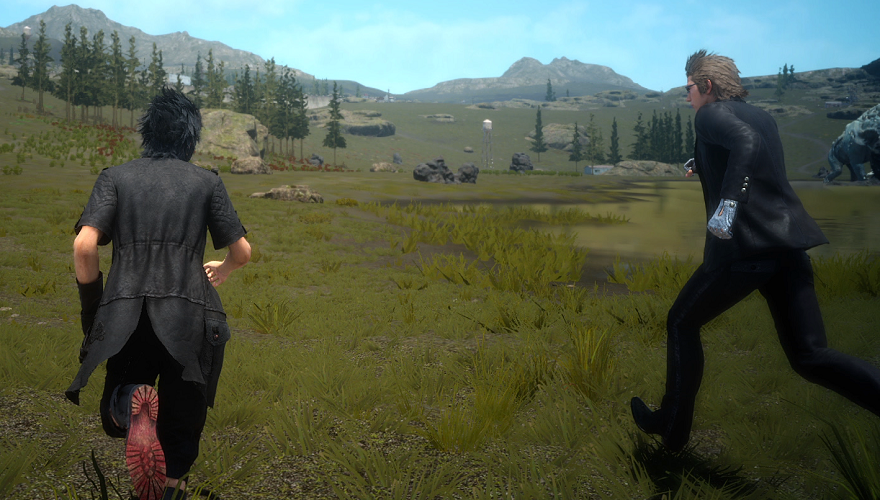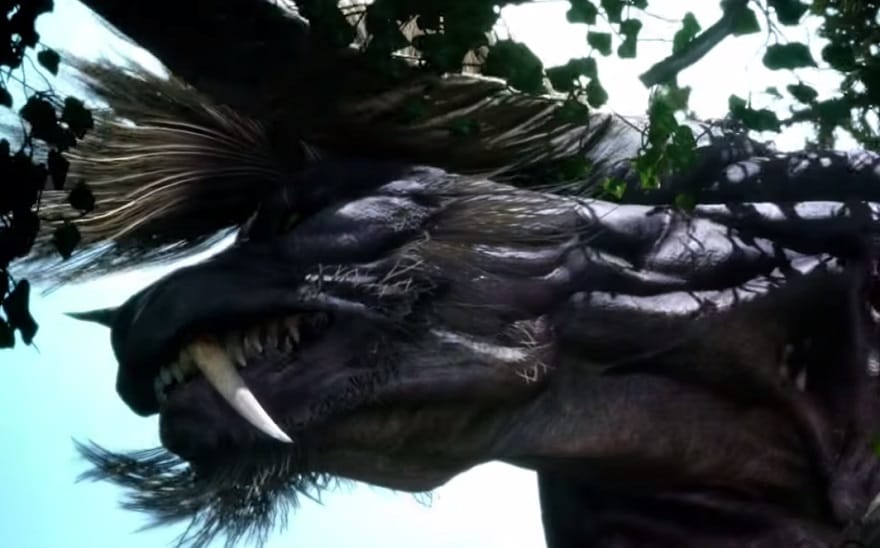On Final Fantasy XV and "the real world"

A few weeks ago, Square Enix released a trailer for Final Fantasy XV that focused exclusively on the game’s wildlife. Not combat, not story, but wildlife: the trailer begins with a shot of the game’s four protagonists running into the background while a simple frog sits placidly in the foreground, signaling loud and clear that this is a showcase for the creatures that creepeth along the same plains, many of them invisible to the player. The trailer calls itself “World of Wonder”—or WOW, with a silhouette of a chocobo in the middle of the “O”—and does a surprisingly good job mimicking the structure and rhythm of a 1980s nature documentary, minus David Attenborough. Static shots, many of them close to the ground, some of them peering through dense thickets of blurry foliage, frame creatures large and small, from the Final Fantasy universe and our own. There’s a familiar combination of the mundane, the majestic, and the fearsome: black chocobos waddle aimlessly toward what is designed to seem like a hidden camera; a more artful shot captures the proud coeurl—a leopard-like monster with the ability to turn players to stone—perched atop a plateau at dusk; a tracking shot, accompanied by the player’s footsteps, wanders into a dark forest full of weird moose and implacable eyes.
With every herd I tried to cull like a filthy poacher, a team of clockwork soldiers descended from the sky
The big intended takeaway seems to be an overwhelming feeling of ecological realism. This is a world in which the footprint left by a behemoth can become the habitat of a frog. This is a world surveyed not just by the great and powerful Bahamut, who will probably show up at some point anyway, but by the bald eagle—which, in terms of deliberate real-world banality, is basically the animal equivalent of the game’s Coleman camping gear and asphalt roads. This is a world, the trailer proclaims, in which the series’ trademark creatures are finally approached as animals rather than monsters.
I wonder about that. Or at least, I wonder why that is. Reactions to the video have been predictable: the first two YouTube comments I saw proclaimed “I am going to genocide the fuck out of everything in this game” and used the black chocobos as an opportunity to say something racist. The more thoughtful people at NeoGAF expressed measured excitement and curiosity about the game’s attention to creaturely detail: “I’m really curious if the animals will have a sleep cycle,” user Plywood wondered aloud. Was anyone even that surprised that Square Enix would make a mock-wildlife documentary about the fauna of its upcoming game? Not really, I don’t think, and for at least one good reason: animal ecologies have been a marquee feature—even a benchmark—of open-world games going all the way back to Metal Gear Solid 3, which wasn’t technically an open-world game but offered many of the freedoms we have come to expect from them. Final Fantasy XV, called Final Fantasy Versus XIII once upon a time, was imagined before the tigers of Far Cry 3 and the grizzlies of Red Dead Redemption, but you can tell that the developers are part of the same zoological arms race, working tirelessly to create a world that feels natural, populated, alive. At the same time, this is Final Fantasy, a series with a very set way of framing and organizing encounters with the nonhuman; a series that has always prioritized aestheticism over everything else; a series not exactly known for feeling natural, populated, or alive. At what point has it ever been important to locate a behemoth’s feeding grounds—to think of it as a creature that has feeding grounds? Why is it so important now?

Scroll to #20 in the bestiary of Final Fantasy V, accessible via the Config menu, and you’ll get a terse readout of basic information about the Garula, a kind of woolly mammoth: what level it is (9), how much HP it has (500), what it drops (nothing). In Final Fantasy XV: Episode Duscae, the demo released on Tuesday alongside Final Fantasy Type-0 HD, they’ve lovingly transformed this obscure and unremarkable creature from the FF back-catalog into a being of zoological complexity. “Garula, woolly wetland dwellers whose tusks are quick to turn on any who harm the herd”—this is the capsule description you get when you encounter one for the first time, and the herd part is 100% accurate: they roam in herds and fight in herds, with large ones protecting smaller ones. (Never before have I seen an RPG in which individual animals of the same species—i.e. not special or “notorious” ones—vary by size.) When I hit one hard enough, it tipped over helplessly in a way that made me feel just … terrible. With every herd I tried to cull like a filthy poacher, a team of clockwork soldiers descended from the sky. Even if they probably didn’t care about the Garulas, in their masked faces I saw the scorn of PETA—a PETA that would not rest.
I didn’t think the demo would be as animal-heavy as the trailer suggested. And it isn’t, in the sense that it has far fewer animals, and almost zero real-world ones: I saw no lizards underfoot, no eagles overhead, no frogs in the shallow ponds. But it is surprisingly animal-centric, in the sense that one of the main things it showcases is what the developers have done to the series’ creatures to make them more animalistic—as well as what they’ve done to the series’ people to make them appear, for the first time, conscious of animality. Would Cloud ever wonder why he was killing 47 Malboros in succession? “I am not into wildlife,” says Prompto, one of the protagonists—a character who looks a bit like Cloud on meth—as one more legion of sabertusks goes down. He’s “more of a pet person.”
what was it about “monsters” that wasn’t ever going to be enough
In JRPGs, collecting and harvesting the skins and body parts of monsters is a game mechanic so universal it has grown beyond a stereotype and into a kind of pillar of the form: games are judged not according to whether they have “fetch quests” but according to how they handle fetch quests. Even the most urban RPG will have people who need you to get things from animals because RPGs have always been about getting things from animals; the basic structure of an RPG depends on the economics of an infinitely teeming wild, on creaturely plenitude converted into character progression, on bestiaries of species that are defined by their drops. Final Fantasy XV is no exception: every Garula produces a “Garula sirloin” that can be consumed over a campfire, and the entire plot of the demo is a hunt for a specific Behemoth that will reward the protagonists with enough money to fix their car. And yet, it’s a Behemoth that must be tracked; a Behemoth that has left footprints both literal and ecological; a Behemoth that the developers have taken pains to define through emergent narrative rather than a statistical readout.
The series rests on the foundation of its “random encounters”; without them, or without something that behaves like them, a Final Fantasy game wouldn’t be a Final Fantasy game. Even as new entries morph old tropes beyond recognition, they retain the structure of that moment—repeated ad infinitum—when the heroes of light come face-to-face with the denizens of the wild, Team Human vs. Team Not. In every entry except this one—and Final Fantasy XII, which tried to do so many things like this one—it’s always happened on a separate screen. In Episode Duscae, the encounters are still framed as battles, and still feel random-ish: at semi-regular intervals throughout the demo, a pack of sabertusks will emerge from the shadows, the battle music will begin in earnest, and they will have to be dispatched. Afterward, the game will tally how long it took to kill them and how much EXP the party earned. But only a thin aesthetic border demarcates these events as ‘battles’ per se. They are battles, but the game allows you—and maybe even urges you—to think of them simultaneously as forms of predation and exploitation. Farming that’s necessary; farming that isn’t. Killing that could have been, might have been, leaving them be.

The main aesthetic project of Final Fantasy XV seems to be superimposing Final Fantasy onto mundane reality, and vice versa: a party of four, on a mythic quest, in a place that has highways and convenience stores and news anchors on the radio. The game’s animals are a crucial part of that project; they also embody—compellingly and unmistakably—all its tensions and contradictions. Every Garula is both Garula the monster, 500 HP, purveyor of EXP and stat-boosting steak, and Garula the animal, living among the herd. “Animal is a word that men have given themselves the right to give,” writes Jacques Derrida in “The Animal That Therefore I Am,” standing naked before his cat. What would he have said about “monster”? Final Fantasy XV asks that question; in a lot of ways it seems designed to beg that question, as it hastily superimposes the structure of a “battle”—a random encounter—onto four dudes killing animals in the woods. It asks questions about why we need animals in our videogames in the first place: what was it about “monsters” that wasn’t ever going to be enough?
At the end of the trailer, the frog is sitting in the same spot when the humans come running back. Its blank stare is the creation of artists and animators, but it fools us for a second. Perhaps there is a valley that lies beyond the uncanny valley, where the uncanny—that combination of the familiar and the unfamiliar that draws us to animals in the first place—is the point. A virtual blankness.



